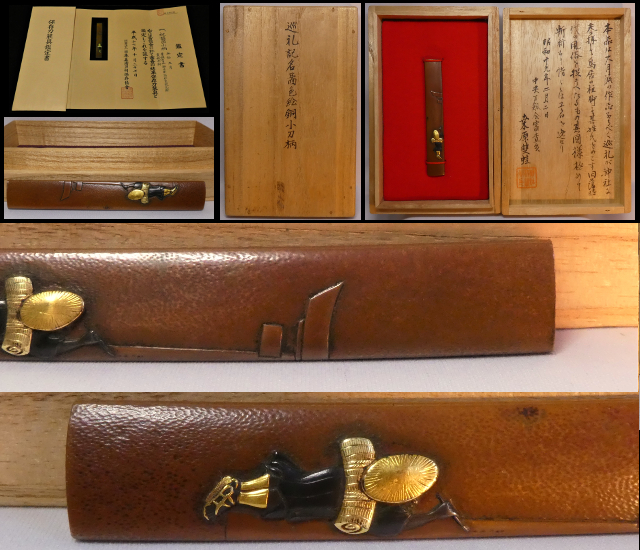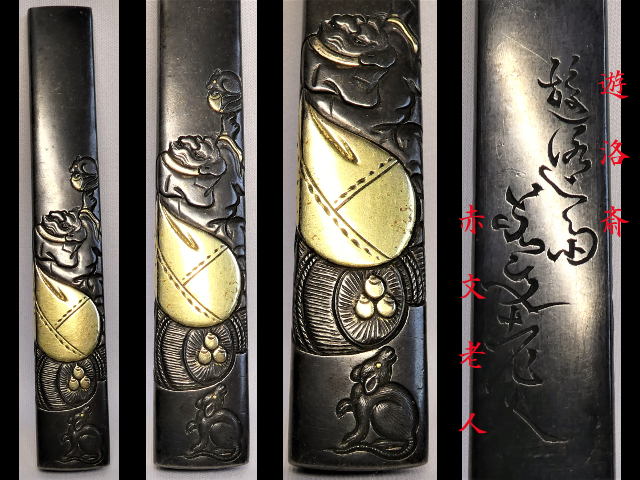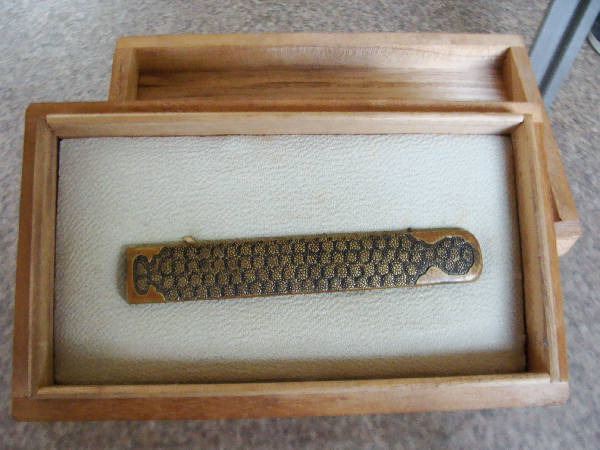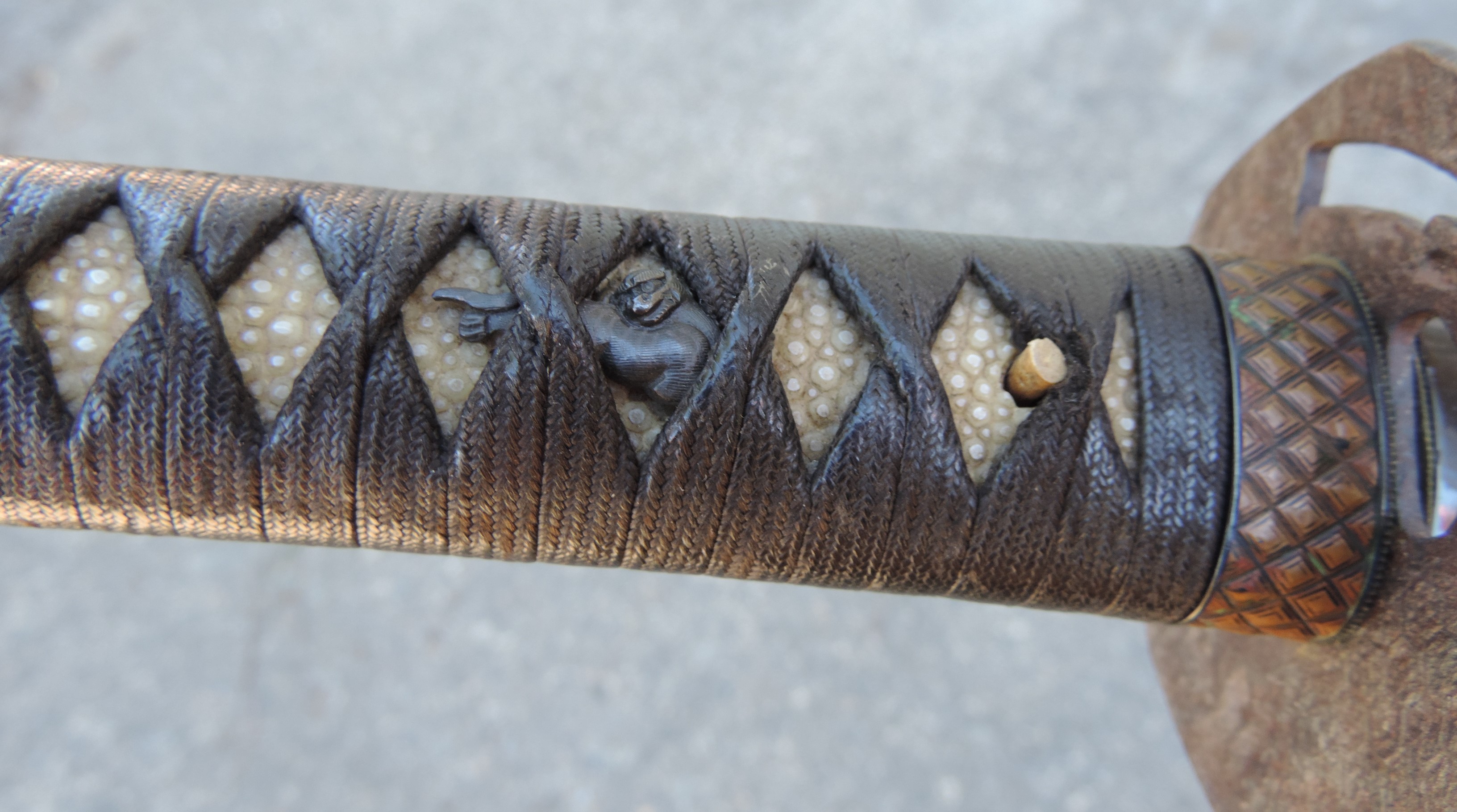|
|
KO-GOTO DAISHO
$2000.00
Provenance: Elliott Long
Accompanied with Sato Kanzan Hakogaki and NBTHK Tokubetsu Kicho (1972) paper.
DaiSho Ko-Goto Menuki.
Early Muromachi period, ca. 1500. |
|
|
UMETADA MENUKI
$2400.00
Provenance: Elliott Long
Accompanied with NBTHK Hozon dated _.
Write-up to follow.
Edo period.
|
|
|
KOKINKO BULL Menuki
$400.00
Provenance: Robert E. Haynes
Katsushirome plate menuki from the same mold.
Early Muromachi period.
3.4cm x 1.3cm x 0.4cm. |
|
|
KIKUKAMONSHO Menuki
$200.00
Provenance: Elliott D. Long
A stylized chrysanthemum pattern derived from the Imperial crest.
Edo period. |
|
|
KOGAI with Ceremonial Pot
$750.00
Provenance: Robert Haynes
"A shakudo kogai with the ji-ita completely gold covered, including the nanako. The design is a ceremonial pot with a long handle, sometimes used to serve sake. This pot contains a large floral spray in high relief. There is also a pine branch and flowers next to the bowl. I do not know the meaning of this design and I was unable to find another example of it in the large book devoted to the study of the kogai." (Haynes) |
|
|
'GOTO INJO' and Kao
$1500.00
"Classic Goto school shakudo kogai. With nanako ji-ita and relief design of a minogame (sea tortoise) with a gold covered shell, and silver lines indicating water. The reverse is signed 'GOTO INJO' and Kao. See H 01896.0." (Haynes) |
|
|
OTSUKI MITSUOKI (Seals)
$800.00
"Copper kozuka with carved design of an elephant and its trainer in low relief. With some gold inlay. The quality of the carving is very fine. The back side has gold strips as if the surface has been rubbed or cut from an overall gold plate. There is minor damage to the butt end of this piece that can be repaired. The bottom third has a large 'pot' seal of very good carving and below a Chinese style seal. These are the seals used by Otsuki Mitsuoki (H 05375.0) born 1766, died Aug. 15, 1834." (Haynes) |
|
|
'KANEYUKI'
$600.00
"Kozuka of dark shibuichi with low relief shishiaibori (as was being used by the Sugiura Joi school shortly before this time). The design is of Hotei with his bag and holding a fan, with some gold inlay. The carving is of very high quality. This example has some damage to the butt end and a large dent in the center of the back plate.
The back is signed, lower left, 'KANEYUKI' (H 02616.0). This is Hamano Kaneyuki, who was the second son of Hamano Shozui, the founder of the Hamano school." (Haynes) |
|
|
'YASUCHIKA' $2400.00
"This kozuka appears to be of shibuichi plate which now has a black lacquer surface that is probably original to the piece. The upper area is carved and inlaid with bold gold waves. The lower end is inlaid with an almost three dimensional mino-game, a sea turtle. The carapace of dark shibuichi and each section outlined in very fine silver wire flush inlay. The body is gold plate and carved in great detail. The reverse is carved with fine line "rain marks" following the vertical form of the plate.
Bottom right is the signature: 'YASUCHIKA' (see H 11104.0). This is the signature of the "First Yasuchika". (Haynes) |
|
|
'KATSURYUKEN MASAYOSHI'
$1500.00
"A shakudo plate kozuka with polished surface. Inlaid in relief with shishimai, also called Dai Kagura figure holding bamboo pole and New Years pine tree. The robe of carved gold and the mane of silver, as is the lower portion of the figure. This is the "lion dance" figure of both Chinese and Japanese culture. A design seen in many Japanese art forms. The back is polished shakudo and is signed, lower center: 'Katsuryuken Masayoshi', (H 04907.0)." (Haynes) |
|
|
'HOSONO SOZAEMON MASAMORI'
$900.00
"A Kozuka of shakudo depicting figures in a landscape with Mount Fuji in the distance. The mei reads... 'HOSONO SOZAEMON MASAMORI' . This prolific artist mostly made minute inlay of figures in various flush metals with surface carving. This is a first-class example of his work." (Haynes & Long)
9.80cm x 1.40cm |
|
|
'SUIFU JU ICHIYOKEN TOSHIHARU'
$2100.00
"A very fine shakudo nanako base metal decorated with autumn grasses in takabori and iroe. The autumn grasses comprise of obana, kuzu nadeshiko, ominaeshi, fujibakama, and asagao which often appear in Japanese art. A shakudo MITO kinko kozuka dating to late Edo period." (Haynes)
Dr. Torigoye Hakogake
SARO + Kao, 1st Class Edo Period. |
|
|
'GOTO MITSUTAKA' and Kao
$2000.00
"A very fine shakudo nanako base metal decorated with Chokaro Sennin (Daoist figure) in takabori and gold zogan.
Signed: 'GOTO MITSUTAKA' and Kao. ( JUJO H 02267.0 ). Same as Shujo. Waki-Goto school. First son of Goto Unjo (H 11062.0) and second master of the Saburoemon line. His most gifted student was Yamazaki Ichiga who later studied with Goto Ichijo." (Haynes)
Dates to Edo period, 18th century.
Dr. Torigoye Hakogake
SARO + Kao, 1st Class Edo Period. |
|
|
'GOTO JUNJO' and Kao
$2000.00
"A very fine shakudo nanako base metal decorated with waves and rocks in shallow nikubori, shibuichi and gold zogan encased in gilt, some inlay missing. The waves are carved in the manner of the mainline Goto.
Signed: 'GOTO JUNJO' (Mitsuaki) and Kao. H 02293.0. Junjo was the son of Beicho Seijo.
Dates to mid Edo period." (Haynes)
Dr. Torigoye Hakogake
SARO + Kao, 1st Class Edo Period. |
|
|
'KOJU'
$1800.00
"A very fine shakudo nanako base metal decorated with
Dr. Torigoye Hakogake
Lost Box, Late Edo Period. |
|
|
NUE MYTH
$1000.00
"A very fine shakudo nanako base metal decorated with a scene from a Noh drama. The figures are in takabori and gold zogan.
Dates to ca. 1600." (Haynes & Long)
The Nue in Noh is a monster, which has a monkey’s head, tiger’s legs, and a snake’s tail (and racoon’s body in the Tale of the Heike). A legend says that it was called Nue because its crying voice sounds similar to that of the White’s Thrush.
Sato Kanzan Hakogake (1964) with two seals. (Very Rare) |
|
|
"SEN-JA MODE" Kozuka
$2500.00
Provenance: Elliott Long.
N.B.T.H.K. Hozon attribution dated Heisei 17, 2005.
Hakogaki by Kubaro Yojoro dated February 2nd, 1944.
"A Kozuka of great elegance depicting a journey." |
|
|
'YURAKUSAI SEKIBUN'
$1800.00
Provenance: Elliott Long
DAIKOKU. Since the 17th century, Daikoku has been most widely known as the Japanese god of wealth and farmers, although in earlier centuries he was considered a fierce protector deity. In Japan, artwork of this deity usually shows him wearing a hood and standing on bales of rice, carrying a large sack of treasure slung over his shoulder and holding a small magic mallet. |
|
|
HIZEN
$500.00
Provenance: Elliott Long
A classic design representing the tachi style of fuchi and kashira. The body of the kozuka represents the 'ray skin' used under the wrap of the tsuka. The amount of work designing this representation was masterful. |
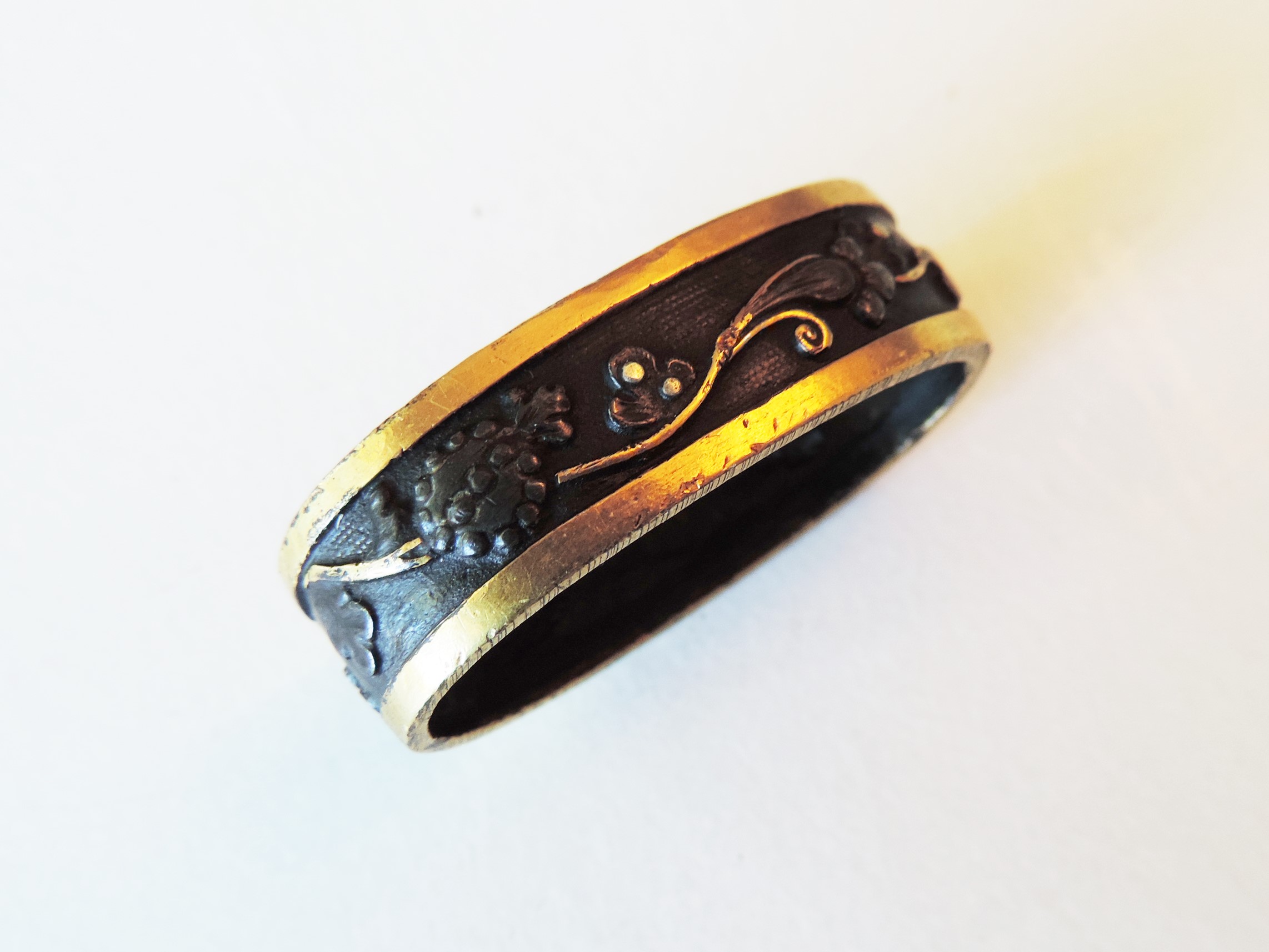 |
FUCHI
$200.00Provenance: Boris Markhasin
Early Edo/Late Momoyama Sendai fuchi of shakudo. Motif of plant life, inlay in shakudo, shibuichi and 24 carat gold. |
 |
|
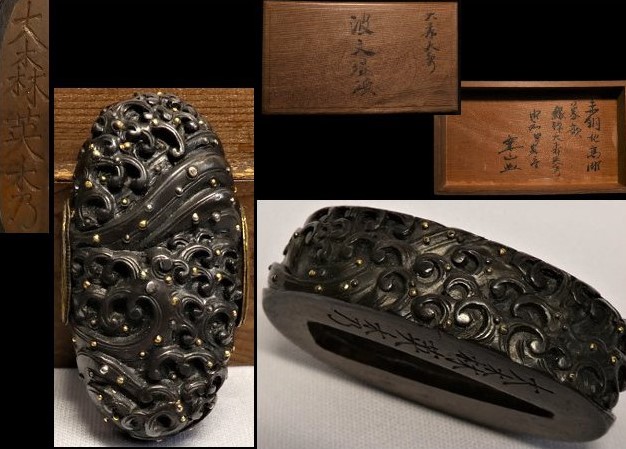 |
|
|
|
Wakizashi Koshirae
$900.00
Provenance: Boris Markhasin
Tiger Menuki in carved Shakudo. Fuchi/Gashira in classic Sendai school style. Iron Tsuba in Nobuiye school style.
Dimensions: Length/74.5cm (29 5/16in), Saya/57.5cm (22 5/8in), Tsuka/16.7cm (6 5/8in) |
|
|
Sho-To Koshirae
$800.00
Provenance: Elliott D. Long
Horse Menuki in Gold-Zogan and Shakudo.
Fuchi/Gashira in Gold and Shakudo.
Tsuba of Shakudo.
Dimensions: Total length/60.5cm (23.81 in), Saya/47.0cm (18.50 in), Tsunagi/42.1cm, Sori/0.7cm. |
|
|
HIGO Tachi-Iron Koshirae
$5000.00
Provenance: Elliott D. Long
Iron Tachi tsuba, mokko shape with four gold outlined nunome.
Gold Shishi Menuki.
Trimmed in Gold - Dual Mons in Ishime Lacquer.
"The Highest Quality." |































